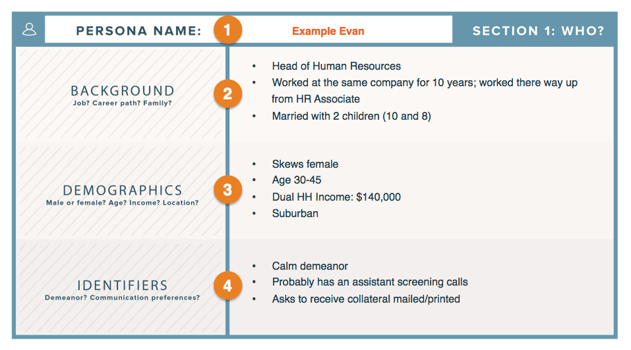What is a Buyer Persona?
Knowing and understanding your market place has always been key for a successful sales & marketing strategy. And with increasing numbers using the Internet as a source for making informed buying decisions, knowing who your buyer is has become vital, and that’s where buyer personas come in as a part of a comprehensive inbound marketing programme.
A buyer persona is a semi-fictional representation of your ideal customer based on various data sources from market research, to existing customer insights and informed assumptions. (HubSpot)
By creating a persona you should be able to visualise what these prospective customers are thinking and doing as they weigh up various options to solve a problem that they are searching to resolve.
So what are the typical reasons we get buyer personas wrong?
- They’re too shallow: Sometimes they’re mistaken for a segmentation strategy and we substitute a job title rather than the details behind the title.
- Gathering dust: Often, buyer personas are created with the best will in the world, but are then left and forgotten about and never updated.
- Out of date: Your buyers life changes every day, with new goals, rules and ways to do things – so your description must keep pace with these changes.
- Navel gazing: Buyer personas are often created with purely internal input. This means they reflect the company’s own assumptions and bias. The most effective buyer personas have input from outside resources and research to get the right balance.
- Cross department fertilisation: Sales, marketing and any department that has customer contact should be a part of the development process for a persona to combine various views to get a true picture of the customer.
- Numerous stakeholders: You need to consider how buying decisions are made, and address the fact that today there are multiple influencers in every B2B buying decision.
- They’re not relevant: To be effective, buyer personas must contain information that is relevant to your business rather than have general statements.
- They don’t translate to tactics: Buyer personas need to have a practical application, do you have the ability to link data, behaviour and tactics to your profile – and check to see if what you are doing is working?
- Don’t get too personal – the focus should be on how the buyer makes a decision.
- Stop basing your analysis on a “gut feeling” – talk to buyers and get their insights rather than use guesswork.
- Don’t develop too many buyer personas, because you will end up with too much work to be able to reap the benefits of a targeted approach.
So what do we need to think about when creating a buyer persona?
Consider the pressures today in a typical B2B buying decision and with so many stakeholders and agendas at play it needs a different type of approach.
With such a complicated buying process there are a number of areas we need to address to get the buyer persona correct:
- We need to understand the way our personas think
- What alternative options do they have, other than selecting your company (who are the competition and what do they offer?)
- What ultimately “tips them over” to buy (the hot buttons that will trigger them into action)?
- Do they have any particular content consumption preferences or habits (you will need to know where to post/distribute your content in order to catch their attention)?
- How can you influence their focus on you as a problem solver (points of digital influence)?
- Can you explain clearly what the buyer’s pain is and how you solve it (this will be a part of your on-line value proposition and messaging)?
So how do I put all this information together and use it effectively?
Since only 30% of content marketers according to the Content Marketing Institute believe that they are effective with their content, creating content that targets a particular persona is increasingly more important if it is to achieve its goals. So for your content to be effective it has to be written with a person in mind, especially if your aim is to stand out from the crowd.
Research has shown that buyers are increasingly relying on internet searches and content from authority sources to make buying decisions, with up to 74% of B2B buyers according to Forrester using this content online to make a purchase offline.
A well drawn up buyer persona will provide an outline on the motivations, challenges and purchase preferences of a prospect.
However, Personas Are Only A Starting Point.
Personas have been around for a while, but they’re growing in popularity because businesses are beginning to shift to an inbound approach to build relationships through deeper insight into buyers and their behaviour. There is now a higher customer expectation of an interaction that is both relevant and personalised. A buyer persona helps sales and marketing to understand what people want and how to interact with them based on their preferences.
A buyer persona is a semi-fictional character created as a picture of an ideal customer, built around insights and common patterns of behaviour. These audience profiles are commonly “pen portraits” including avatars and fictional names that help us visualise and entrench the picture in our mind of the buyer long after we have read the memo.
The persona provides rich insight that can be picked up by sales and marketing to guide a sales strategy, help marketers design a campaign and work on engagement plans and digital experiences to generate and nurture leads.
Which Companies Can I Help? – Identify The Ideal Buyer Profile.
Before you can identify potential buyers, you need to define which buyers you can help and which buyers you can’t. This is called the Ideal Buyer Profile.
In a B2B context, here are some questions to consider when defining your ideal buyer profile.
- Company size?
- Industries/verticals?
- Geographic locations?
- Attributes of your buyer’s customers?
The ideal buyer profile defines which companies are a good fit for what you offer and which ones are not. The buyer persona defines the different buying patterns of people within your ideal buyer profile that you are going to target.

Conclusion
Once you are satisfied that you are working with an effective buyer’s persona, the next stage is to integrate your plans into a comprehensive inbound marketing programme – to help you attract leads and nurture them along your sales funnel. And let us know if you need help to understand your buyers pain.

